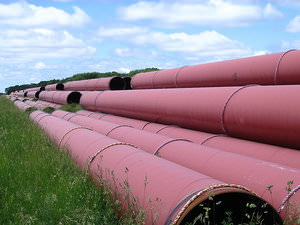Oil Pipeline Protesters Arrested
Hundreds of environmental activists have shown up outside the White House this week -- prepared to risk arrest -- to protest a proposed transnational oil pipeline project they say will do more harm than good. More than 200 people have already been arrested.
Hundreds of environmental activists have shown up outside the White House this week — prepared to risk arrest — to protest a proposed transnational oil pipeline project they say will do more harm than good. More than 200 people have already been arrested.
The protest began Aug. 20 and demonstrators intend to continue through Labor Day while the State Department puts the finishing touches on a final environmental impact statement on the proposal that it is expected to release by the end of the month. More than 2,000 people signed up to participate during the 14-day protest, with the bulk of the demonstrating planned for Saturday.
The proposed 1,661-mile pipeline — the Keystone XL — would carry as much as 900,000 barrels of oil a day from tar sands in Canada to refineries in Texas. But what really has environmentalists concerned is that not only does the type of oil extracted from tar sands have a carbon output that is 20 percent higher than more conventional oil supplies, an analysis of the proposed pipeline has estimated that about 91 “significant spills” would occur as a result of the Keystone XL over the next 50 years. And that doesn’t even begin to go into the damage that would be done to air and water supplies at the extraction site. –BF
Your support matters…Mother Jones:
What’s wrong with building a giant pipeline across the US? That existing Keystone line has already leaked a dozen times in just one year of operation. The Keystone XL would cross more than 70 rivers and streams, including the Missouri, Platte, Yellowstone, and Arkansas. The oil spill from another pipeline in the Yellowstone River last month didn’t do much to allay those concerns. It would also cross the Ogallala Aquifer, which provides nearly one-third of the groundwater used to irrigate US crops, supports $20 billion in agriculture, and supplies drinking water to about 2 million people. A recent report from a researcher at the University of Nebraska estimated that there would be 91 significant spills from the pipeline in the next 50 years. A worst-case-scenario spill in Nebraska’s sand hills above the Ogallala Aquifer could dump as much as 180,000 barrels, tainting the vast water supply in the region.
The much-higher carbon footprint of tar sands oil and its contribution to climate change are also concerns, as are the health problems reported near extraction sites.
Independent journalism is under threat and overshadowed by heavily funded mainstream media.
You can help level the playing field. Become a member.
Your tax-deductible contribution keeps us digging beneath the headlines to give you thought-provoking, investigative reporting and analysis that unearths what's really happening- without compromise.
Give today to support our courageous, independent journalists.






You need to be a supporter to comment.
There are currently no responses to this article.
Be the first to respond.